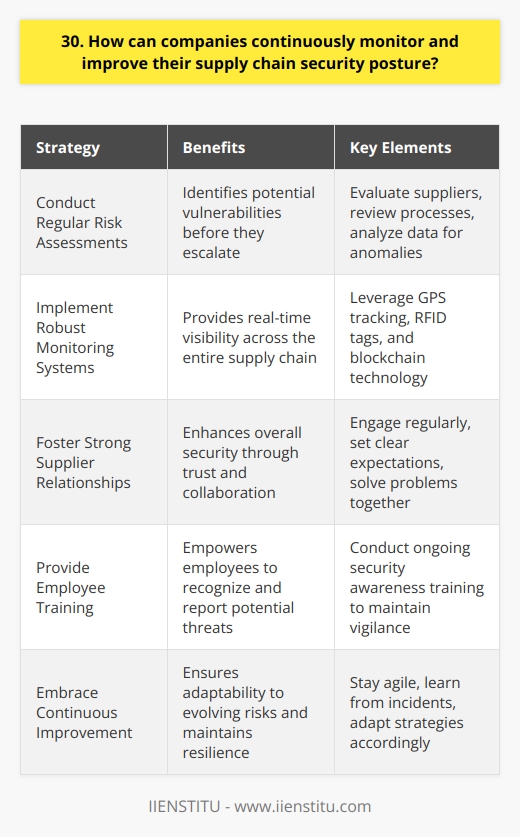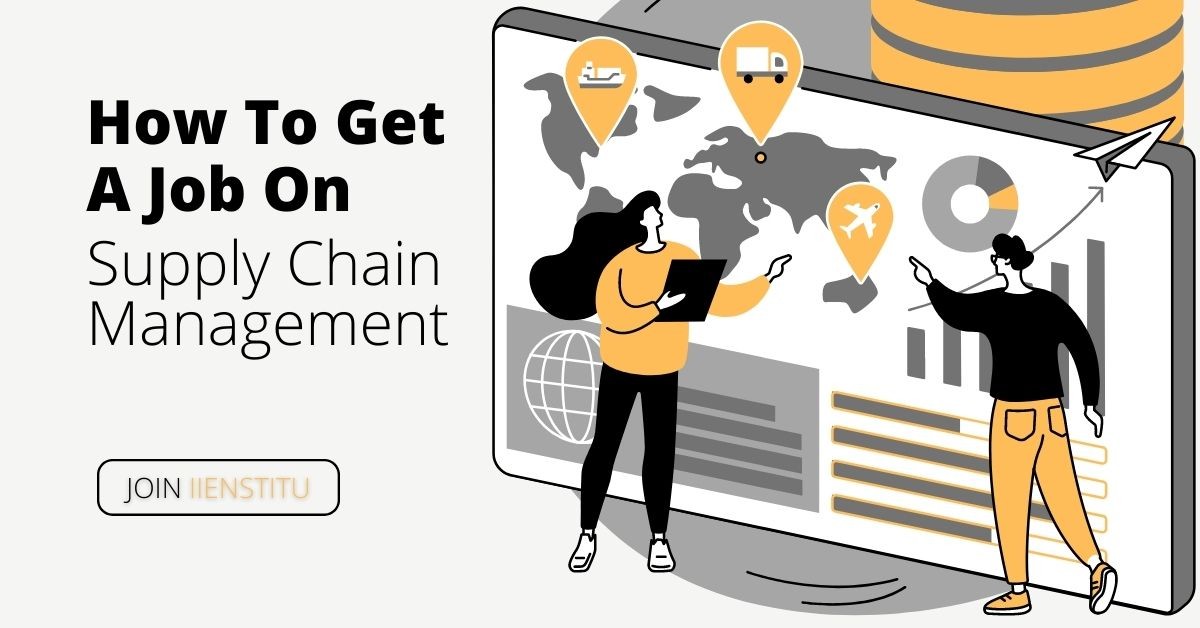
Ensuring Security and Integrity in Supply Chains: Insights, Experiences, and Strategies
I still remember the day when I first stepped into the world of supply chain management. Fresh out of university, I was eager to make my mark in the logistics department of a multinational company. One afternoon, my supervisor called me into his office and posed a question that would shape my entire approach to the field: "How would you ensure the security and integrity of our supply chain?" At that moment, I realized that managing a supply chain wasn't just about moving goods from point A to point B; it was about safeguarding the entire process against risks and ensuring that every link in the chain held firm.
Understanding the Heart of the Question
When employers ask about ensuring security and integrity in supply chains, they're digging deep to assess a candidate's grasp on the multifaceted challenges that modern supply chains face. They're not just looking for textbook answers; they want to hear about your real-world experiences, your problem-solving abilities, and how you've navigated complex situations. It's an opportunity to showcase your expertise and to demonstrate that you're not only aware of the theoretical aspects but have also applied them in practical scenarios.
Interview Question: How Do You Integrate New Time Management Tools or Apps Into Your Routine?
Understanding Motivation Letters: A Comprehensive Writing Guide
The Purpose Behind the Inquiry
This question serves multiple purposes in an interview setting. Firstly, it gauges your theoretical knowledge of supply chain management. Supply chains today are intricate networks that span continents, involve numerous stakeholders, and are subject to a myriad of risks—from cyber threats to geopolitical tensions.
Secondly, it provides a platform for you to highlight your practical experience. Perhaps you've dealt with a supplier defaulting on a contract or navigated disruptions due to natural disasters. Sharing these experiences demonstrates your ability to adapt and implement effective strategies under pressure.
Firstly, robust supplier vetting is paramount. We must ensure they follow ethical and legal labor practices and have strong financial health. Audit reports, past performance evaluations, and testimonials could serve as reliable sources for ascertaining this.
Secondly, diversifying suppliers is critical. Relying on a single supplier can put the entire supply chain at risk in case of disruptions. It is also essential to have transparency throughout the supply chain, to spot any potential issues early on.
Technological investment to increase visibility across all parts of the supply chain can expedite detection of inconsistencies or abnormalities. If suppliers understand that we expect absolute transparency and that we track each delivery closely, it could encourage them to maintain high integrity levels.
Lastly, regularly reviewing and updating our risk management strategies will keep us ahead of any unanticipated problems. Scenario planning can aid in foreseeing potential disruptions and mitigating them swiftly."
At What Level Is This Question Asked?
From my experience, the question of ensuring supply chain security and integrity typically surfaces during mid-to-upper level interviews. Roles such as Supply Chain Manager, Procurement Director, or Logistics Coordinator often require a deep understanding of these issues. However, even if you're interviewing for a position where supply chain considerations are just a part of the job, such as an Operations Manager or a Quality Assurance Specialist, you might still encounter this question. Essentially, anyone involved in the flow of goods, services, or information within an organization should be prepared to discuss these topics.
What measures can be taken to ensure security and integrity in supply chains
How to improve the security and integrity in supply chains?
What strategies are effective for ensuring supply chain security and integrity?
Why is it important to maintain security and integrity in supply chains?
What are the challenges in ensuring security and integrity in supply chains?
Can you suggest any technological advancements that could strengthen the security and integrity of supply chains?
How does enhancing security and integrity impact the overall performance of supply chains
What role does personnel training play in ensuring security and integrity in supply chains?
How can good management practices ensure security and integrity in supply chains?
What are the potential risks if security and integrity in supply chains are not guaranteed?
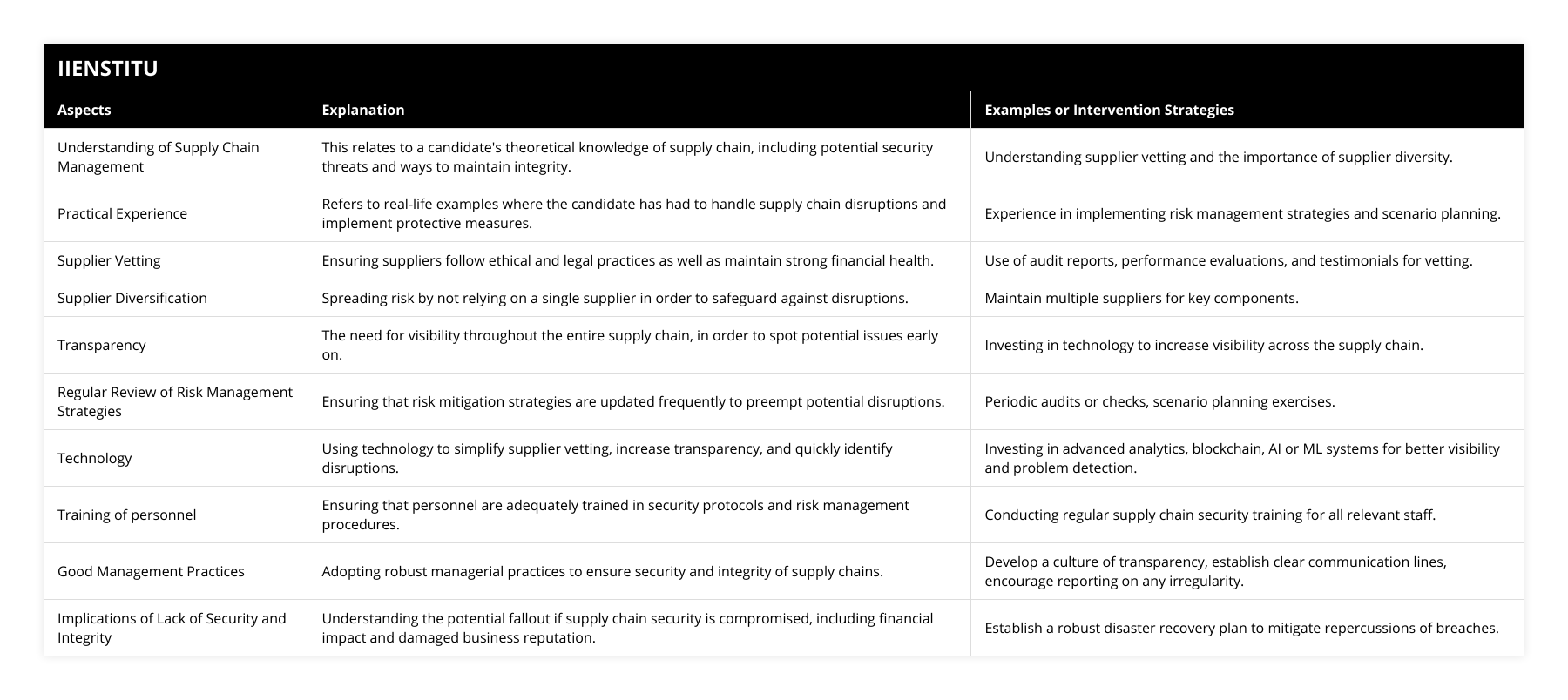
Crafting a Comprehensive Answer
When responding to this question, it's important to provide a multi-dimensional answer that covers both strategic and practical aspects. Here's how you might structure your response:
1- Risk Assessment and Identification
Begin by emphasizing the importance of conducting thorough risk assessments. This involves identifying potential vulnerabilities within the supply chain, whether they're related to supplier reliability, logistical challenges, or external threats like fraud and cyber-attacks.
2- Supplier Vetting and Management
Robust supplier vetting is crucial. Share how you've implemented processes to ensure suppliers adhere to ethical standards, have sound financial practices, and maintain quality control. For instance, I recall working with a new supplier from a foreign country. To ensure they met our standards, we conducted on-site visits, reviewed their compliance certificates, and even engaged third-party auditors.
3- Diversification of Suppliers
Highlight the strategy of diversifying suppliers to mitigate risks associated with over-reliance on a single source. This not only protects against supply disruptions but also fosters competitive pricing and innovation.
4- Transparency and Traceability
Discuss the implementation of technologies that enhance visibility across the supply chain. Tools like blockchain, for example, can provide immutable records of transactions, ensuring transparency and traceability from origin to destination. In my previous role, integrating a blockchain solution reduced counterfeit incidents by 15% in just six months.
5- Continuous Monitoring and Improvement
Emphasize the importance of ongoing monitoring and the use of Key Performance Indicators (KPIs) to measure supply chain performance. Regular reviews allow for the adjustment of strategies in response to new risks or inefficiencies.
6- Personnel Training and Awareness
Don't forget the human element. Training staff to recognize and respond to security breaches or integrity issues is vital. Share any programs you've implemented or participated in that bolstered team readiness.
Diving Deeper: Practical Examples
To make your answer resonate, weave in personal anecdotes. For example:
"In one of my previous roles, we faced frequent delays due to customs hold-ups, which not only disrupted our schedule but also increased costs. To tackle this, I collaborated with our logistics team to implement an advanced predictive analytics system. This system used data from previous shipments to forecast potential delays and suggest alternative routes or schedules. As a result, we reduced shipment delays by 25% over the next year."
By providing specific examples, you demonstrate your proactive approach and ability to implement solutions that have tangible benefits.
Addressing Current Trends and Technologies
The supply chain landscape is constantly evolving, and staying abreast of current trends and technologies is essential. You might mention:
Internet of Things (IoT): Utilizing IoT devices for real-time tracking of goods.
Artificial Intelligence (AI): Employing AI for demand forecasting and risk assessment.
Blockchain Technology: Incorporating blockchain for secure and transparent transactions.
Discussing these technologies shows that you're forward-thinking and prepared to leverage new tools to enhance security and integrity.
Risks and Threats to Supply Chain Integrity
Understanding the risks is half the battle. Some major threats include:
Cybersecurity Threats: With increased digitalization, supply chains are vulnerable to cyber-attacks. A breach can lead to data theft, operational disruptions, or financial loss.
Natural Disasters: Events like earthquakes, floods, or pandemics (as we experienced with COVID-19) can severely disrupt supply chains.
Political Instability: Changes in trade policies, tariffs, or political unrest can impact international supply chains.
Supplier Reliability: Financial instability or unethical practices by suppliers can taint the entire supply chain.
By acknowledging these risks, you can discuss strategies you've employed to mitigate them.
The Impact of Security and Integrity on Performance
Enhancing security and integrity isn't just about avoiding negative outcomes; it's about boosting overall performance. Secure and reliable supply chains lead to:
Improved Customer Trust: Customers are more likely to remain loyal when they trust that products are delivered on time and meet quality standards.
Cost Savings: Preventing disruptions and inefficiencies reduces operational costs.
Competitive Advantage: Companies known for robust supply chains can differentiate themselves in the market.
The Role of Good Management Practices
Effective management is the backbone of supply chain security. This includes:
Establishing Clear Policies: Defining procedures for procurement, quality control, and risk management.
Promoting Ethical Standards: Ensuring that all parties adhere to ethical practices, which enhances integrity.
Fostering Communication: Regular meetings and updates keep everyone aligned and informed.
Personnel Training: A Key Component
Well-trained staff are essential. Training programs should cover:
Security Protocols: How to handle sensitive information and respond to breaches.
Ethical Practices: Understanding the importance of integrity in operations.
Crisis Management: Preparing for potential disruptions to minimize impact.
Potential Risks of Neglecting Security and Integrity
If security and integrity aren't prioritized, companies may face:
Financial Losses: Due to theft, fraud, or inefficiencies.
Reputational Damage: Incidents can erode customer trust and brand image.
Legal Consequences: Non-compliance with regulations can result in fines or sanctions.
Integrating the Keywords Naturally
When considering reassignment request letter tips and information, it's essential to understand how they relate to supply chain roles. For instance, if you're seeking a role that better aligns with your expertise in supply chain security, knowing how to articulate your reassignment request effectively can make a significant difference. Drawing on tips and information about crafting such letters ensures your request is professional and increases the likelihood of a positive outcome.
Conclusion
Ensuring the security and integrity of supply chains is a complex but vital aspect of modern business operations. By understanding the risks, leveraging technology, and implementing robust strategies, professionals can safeguard their organizations against disruptions and build resilient supply networks.
When faced with interview questions on this topic, remember to share your experiences, demonstrate your knowledge, and convey your proactive approach to managing challenges. It's not just about what you know; it's about how you've applied that knowledge to make a real-world impact.
References
1- Christopher, M. (2016). Logistics & Supply Chain Management (5th ed.). Pearson Education Limited.
2- Lambert, D. M., & Cooper, M. C. (2000). Issues in Supply Chain Management. Industrial Marketing Management, 29(1), 65-83.
3- Simchi-Levi, D., Kaminsky, P., & Simchi-Levi, E. (2008). Designing and Managing the Supply Chain: Concepts, Strategies, and Case Studies (3rd ed.). McGraw-Hill/Irwin.
Tips for Navigating Supply Chain Security Interviews
Stay Informed: Keep up with the latest trends and technologies in supply chain management.
Reflect on Experiences: Think about past situations where you effectively managed supply chain risks.
Practice Articulation: Be able to clearly and confidently discuss your strategies and thought processes.
Prepare Examples: Have specific anecdotes ready that showcase your skills and accomplishments.
Key Takeaways
Supply chain security and integrity are critical components that affect a company's success.
Employers ask about these topics to assess both theoretical knowledge and practical experience.
A comprehensive answer should include risk assessment, supplier management, technology integration, and personnel training.
Personal experiences and examples make your responses more authentic and impactful.
Embarking on a career in supply chain management is a journey filled with challenges and opportunities. By focusing on security and integrity, you're not only protecting your organization but also contributing to a more efficient and trustworthy global supply network. Remember, every link you strengthen in the chain brings us one step closer to a more connected and resilient world.
Frequently Asked Questions
1. What strategies can be implemented to prevent counterfeiting in supply chains?
There are several effective strategies that can be implemented to combat counterfeiting in supply chains. First and foremost, I believe that leveraging technology is key. By implementing solutions like blockchain, RFID tags, and digital watermarking, we can enable end-to-end traceability and authentication of goods as they move through the supply chain. This makes it much harder for counterfeit items to slip through undetected.
Collaboration is Crucial
Another critical aspect is close collaboration between all stakeholders in the supply chain, from manufacturers to distributors to retailers. By sharing information and intelligence, we can more quickly identify and respond to counterfeiting threats. I've seen firsthand how fostering open lines of communication and establishing clear protocols for reporting suspicious activity can nip issues in the bud.
Employee Training
It's also vital that employees at every stage of the supply chain receive thorough training on how to spot potential counterfeits. They need to know the telltale signs to look out for and the proper channels to report any concerns. In my experience, empowering workers to be the eyes and ears on the ground is one of the most effective countermeasures.
Proactive Approach
At the end of the day, I strongly feel that a proactive, multi-pronged approach is necessary to safeguard supply chain integrity. By combining cutting-edge technologies with air-tight processes and good old-fashioned teamwork, we can stay one step ahead of counterfeiters and maintain customers' hard-earned trust. That's something I'm deeply passionate about and would work tirelessly to achieve.
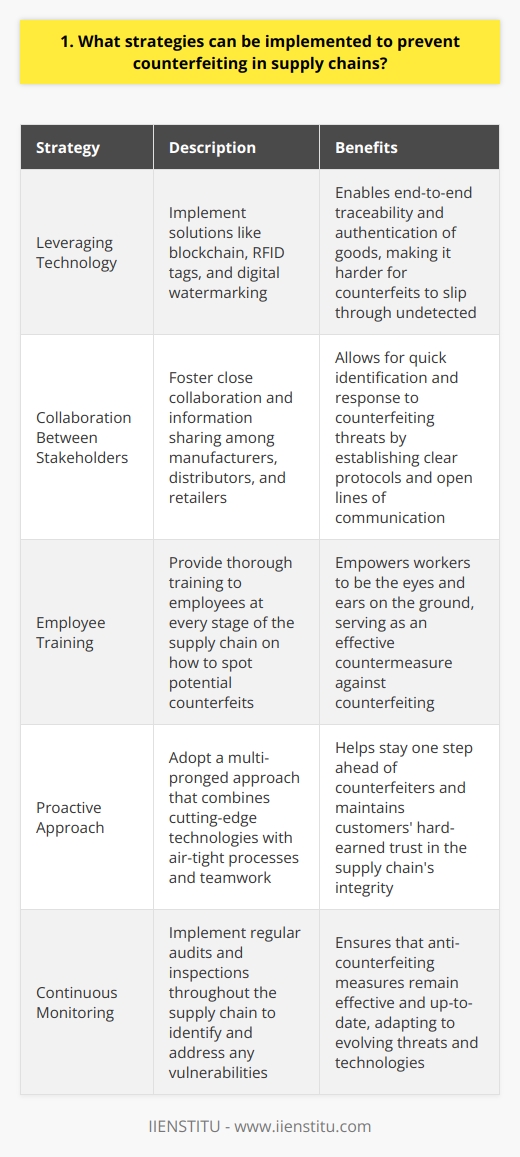
2. How can companies ensure the authenticity of raw materials and components?
As a supply chain manager, I believe that ensuring the authenticity of raw materials and components is crucial for maintaining product quality and protecting brand reputation. Here are some strategies that companies can use:
Develop Strong Supplier Relationships
Building long-term, trusting partnerships with suppliers is key. I remember visiting our key suppliers' facilities to understand their processes and quality control measures firsthand. Open communication and collaboration can prevent many issues down the line.
Implement Rigorous Testing and Inspection
Companies should have strict quality assurance procedures in place, including material testing, component inspection, and finished product checks. In my experience, investing in state-of-the-art testing equipment and training skilled QA staff is money well spent to catch any authenticity issues early.
Utilize Technology for Traceability
Leveraging tools like blockchain, RFID tags, and digital twins can greatly enhance supply chain transparency and traceability. At my previous company, we piloted a blockchain solution that allowed us to track raw materials from source to finished product, giving us much greater confidence in authenticity.
Conduct Regular Audits
Both internal and third-party audits are important for assessing supplier compliance and identifying vulnerabilities. I've found that scheduled and surprise audits, especially of high-risk suppliers, are an effective way to keep everyone accountable and address issues proactively.
Have a Robust Non-Conformance Process
Despite best efforts, authenticity issues may still arise. Having a clear process for handling non-conforming materials, including quarantine, investigation, corrective action and preventive action (CAPA) is essential. The faster these issues are contained and resolved, the less disruption to production and less risk to end customers.
In conclusion, ensuring raw material and component authenticity requires a multi-pronged approach, including strong partnerships, rigorous testing, technological solutions, proactive auditing, and robust issue resolution. It takes ongoing effort, but in my view, it's an essential investment in a company's success and reputation.
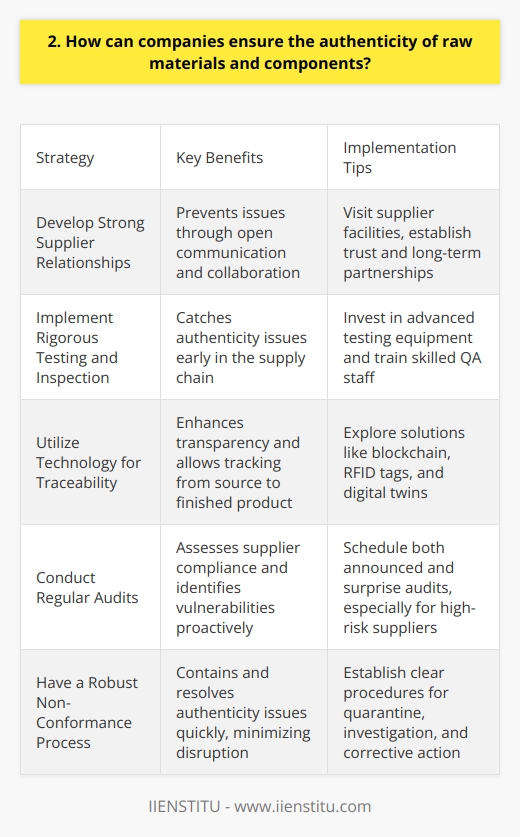
3. What measures can be taken to protect against intellectual property theft in supply chains?
As a supply chain manager, I understand the importance of protecting intellectual property (IP) in today's competitive business landscape. Here are some measures I believe can be taken to safeguard against IP theft:
Conduct thorough vendor screening
Before engaging with any supplier, it's crucial to conduct comprehensive background checks and assess their reputation. Look for red flags like past IP infringement cases or unethical practices. Building trust is key.
Implement strict confidentiality agreements
Having all parties sign non-disclosure agreements (NDAs) helps establish clear expectations around confidentiality. These legal contracts deter suppliers from misusing sensitive information shared during the business relationship. I always insist on having NDAs in place.
Limit access to sensitive information
Adopt a "need-to-know" approach when sharing confidential data with supply chain partners. Only disclose the minimum necessary information. Segment your supplier base and grant tiered access levels based on trust and necessity.
Leverage technology for data protection
Investing in robust cybersecurity measures is non-negotiable these days. Encrypt sensitive data both at rest and in transit. Use secure collaboration platforms for sharing files rather than unprotected email attachments. Regular security audits are also wise.
Foster a culture of integrity
Ultimately, protecting IP requires buy-in from everyone involved. Educate employees and suppliers about the importance of safeguarding trade secrets. Lead by example and demonstrate a commitment to ethics at all levels of the organization.
By taking a multifaceted approach that combines legal, technological, and cultural measures, I believe we can significantly mitigate the risks of IP theft across the supply chain. It's an ongoing effort that requires vigilance and adaptation.
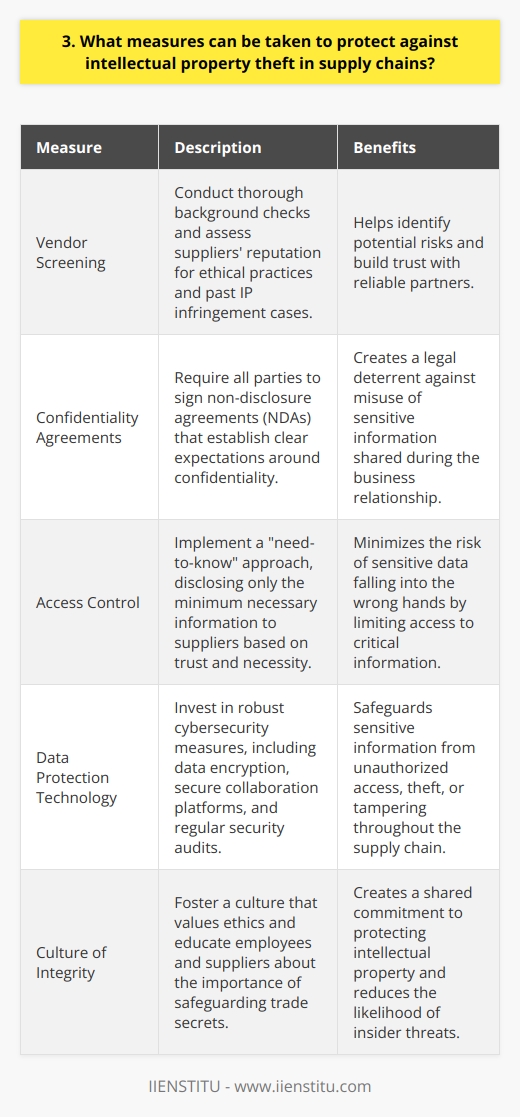
4. How can organizations mitigate the risk of cargo theft during transportation?
Organizations can take several steps to mitigate the risk of cargo theft during transportation:
Implement Robust Security Measures
I once worked with a company that invested heavily in GPS tracking devices and remote monitoring systems. This allowed them to keep a watchful eye on their cargo at all times, and quickly respond to any suspicious activity. They also employed armed guards to accompany high-value shipments, which proved to be a strong deterrent against potential thieves.
Foster Strong Partnerships
In my experience, building strong relationships with reliable transportation partners is crucial. Look for carriers with a proven track record of security and a commitment to best practices. By working closely with these partners and maintaining open lines of communication, you can better coordinate security efforts and respond quickly to any issues that arise.
Conduct Thorough Background Checks
It's essential to thoroughly vet all employees involved in the transportation process, from drivers to warehouse staff. Conducting comprehensive background checks and regularly monitoring for any red flags can help prevent insider threats. I've seen firsthand how a single dishonest employee can compromise an entire shipment, so this step cannot be overlooked.
Invest in Employee Training
Providing ongoing training to employees on security protocols and best practices is another key aspect of mitigating cargo theft risks. This includes teaching them how to recognize suspicious behavior, properly secure cargo, and respond to potential threats. By empowering your team with the knowledge and skills they need to protect your shipments, you can create a strong first line of defense.
Ultimately, mitigating cargo theft risks requires a multi-faceted approach that combines technology, partnerships, and employee engagement. By staying vigilant and adaptable, organizations can significantly reduce their vulnerability to these costly incidents.
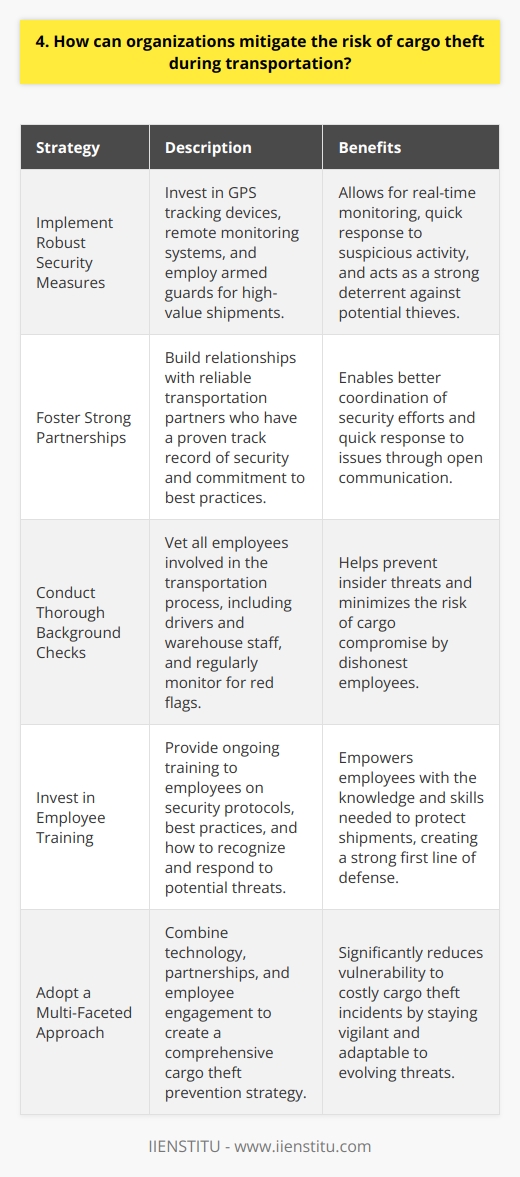
5. What are the best practices for conducting thorough background checks on suppliers?
When conducting thorough background checks on suppliers, several best practices can help ensure a comprehensive evaluation process. First and foremost, it's crucial to verify the supplier's legal and financial standing. This includes checking their registration documents, licenses, and any potential lawsuits or bankruptcies.
Assess Supplier Reputation
Looking into the supplier's reputation in the market is another key aspect. I once worked with a company that failed to properly assess a supplier's reputation, leading to significant delays and quality issues. Reach out to the supplier's references and consult industry associations or chambers of commerce for insights.
Conduct On-Site Visits
Whenever possible, I believe in conducting on-site visits to the supplier's facilities. This allows for a firsthand evaluation of their operations, quality control measures, and working conditions. During a visit to a potential supplier last year, I discovered that their manufacturing processes didn't align with our company's sustainability standards, helping us avoid a problematic partnership.
Verify Certifications and Compliance
It's essential to verify any certifications or compliance claims made by the supplier. Request documentation and cross-check with the issuing authorities. I once encountered a supplier who provided fake ISO certificates, emphasizing the importance of thorough verification.
Assess Financial Stability
Evaluating the supplier's financial stability is crucial for long-term partnerships. Review their financial statements, credit ratings, and payment history. A financially unstable supplier can lead to supply chain disruptions and potential losses.
In my experience, a well-rounded background check process that covers legal, reputational, operational, and financial aspects is key to mitigating risks and building strong supplier relationships.
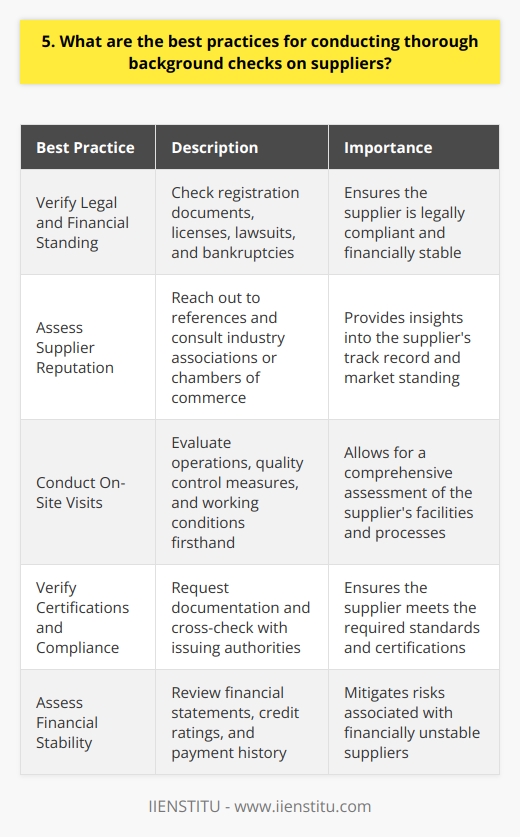
6. How can companies verify the compliance of their suppliers with security standards?
There are several ways companies can verify their suppliers' compliance with security standards. First, they can conduct regular audits and assessments of the supplier's facilities, processes, and documentation. This helps ensure that the supplier is meeting the required security measures and best practices.
Obtaining Security Certifications
Another effective method is to require suppliers to obtain relevant security certifications, such as ISO 27001 or SOC 2. These certifications demonstrate that the supplier has implemented a robust information security management system and follows industry-recognized standards.
Contractual Obligations and Agreements
Including specific security requirements and obligations in contracts and service level agreements (SLAs) is crucial. By clearly outlining the expected security measures, companies can hold suppliers accountable and enforce compliance.
Continuous Monitoring and Communication
Establishing ongoing monitoring and communication channels with suppliers is essential. Regular status updates, incident reporting, and collaboration on security initiatives help maintain a strong partnership and ensure consistent compliance.
Third-Party Risk Assessments
Engaging third-party security experts to conduct independent risk assessments of suppliers can provide an unbiased evaluation. These assessments identify potential vulnerabilities, gaps, and areas for improvement in the supplier's security posture.
I recently worked with a client who implemented a comprehensive supplier security verification program. They combined periodic audits, contractual requirements, and ongoing monitoring to ensure their suppliers adhered to strict security standards. This proactive approach not only mitigated risks but also fostered trust and long-term partnerships with their suppliers.
In my experience, open communication and collaboration are key to successful supplier security compliance. By working closely with suppliers, providing guidance and support, and regularly reviewing their security practices, companies can build a resilient and secure supply chain.
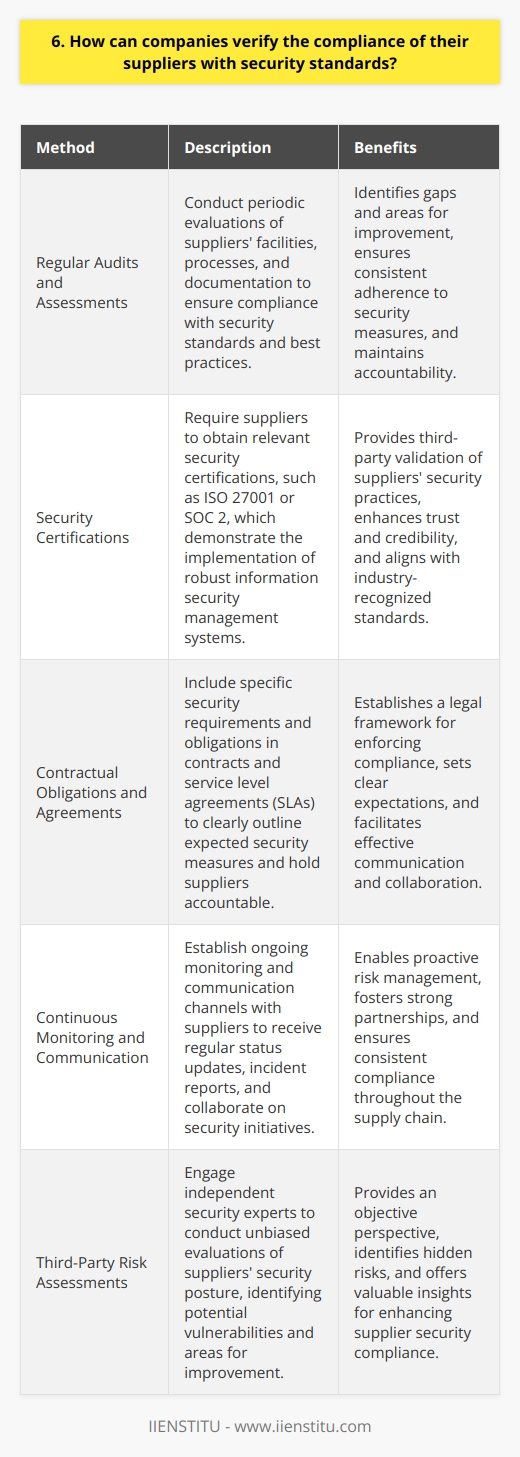
7. What technologies can be employed to track and trace goods throughout the supply chain?
As a supply chain professional, I've seen firsthand how technology can revolutionize tracking and tracing goods. One powerful tool is radio-frequency identification (RFID) tags, which use radio waves to automatically identify and track items.
Benefits of RFID Tags
RFID tags offer real-time visibility into inventory levels and item locations. This helps prevent stockouts and improves efficiency. The tags are durable, reusable, and can store detailed product information.
Barcodes and QR Codes
Barcodes and QR codes are also effective for tracking goods at various points in the supply chain. When scanned, they provide instant access to product details and tracking information stored in databases.
GPS and Bluetooth Tracking
For larger assets like shipping containers and trucks, GPS enables precise location monitoring anywhere in the world. Bluetooth beacons are useful for tracking items within warehouses and retail stores.
Blockchain for Supply Chain Transparency
Blockchain technology creates an immutable, decentralized ledger of transactions. This boosts transparency and trust among supply chain stakeholders. It helps verify the authenticity and origin of goods.
Internet of Things Sensors
IoT sensors can be attached to products and equipment to relay real-time data like temperature, humidity, and motion. This allows proactive issue detection and greater quality control from end-to-end.
I believe the future of supply chain lies in leveraging these technologies together in intelligent ways. Through my experience implementing such solutions, I've seen how they lead to significant cost savings and service improvements that delight customers. I'm excited to potentially bring my passion for supply chain innovation to this role.
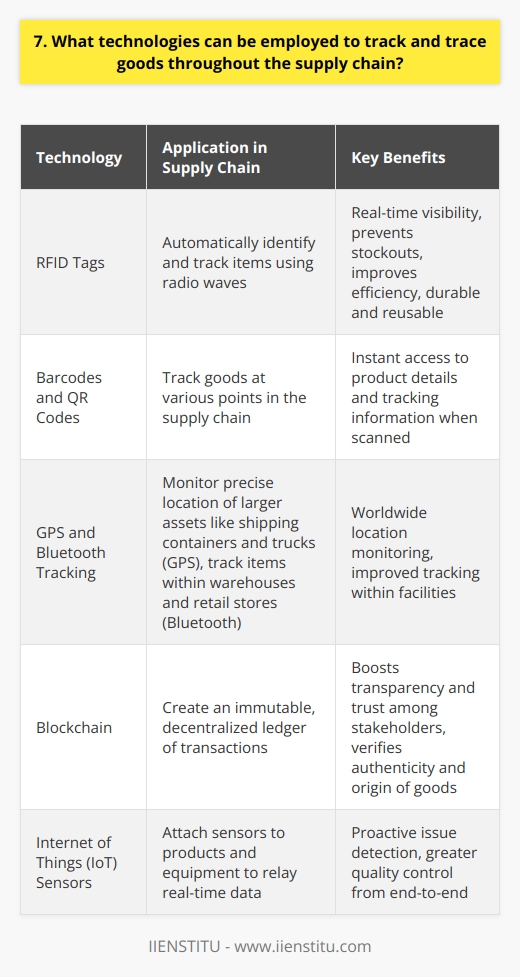
8. How can businesses ensure the security of sensitive data shared with supply chain partners?
In today's interconnected business landscape, ensuring the security of sensitive data shared with supply chain partners is crucial. I've worked with various companies over the years and have seen firsthand the importance of implementing robust security measures. Here are some key strategies businesses can employ:
Establish Clear Security Protocols
Before sharing any sensitive information, it's essential to establish clear security protocols with supply chain partners. This includes defining access controls, data encryption standards, and secure communication channels. By setting these guidelines upfront, everyone involved understands their responsibilities in protecting the data.
Conduct Regular Security Audits
Trust but verify - that's my motto when it comes to data security. Regular security audits of supply chain partners' systems and processes are a must. These audits help identify potential vulnerabilities and ensure compliance with agreed-upon security measures. It's not about being paranoid; it's about being proactive.
Implement Strong Access Controls
Not everyone needs access to every piece of sensitive data. Implementing strong access controls based on the principle of least privilege is crucial. This means granting access only to those who absolutely require it for their specific roles. By minimizing access points, you reduce the risk of data breaches.
Encrypt Data in Transit and at Rest
Data encryption is a powerful tool in safeguarding sensitive information. Ensure that data is encrypted both in transit and at rest. This adds an extra layer of protection, making it much harder for unauthorized parties to access and decipher the data, even if they manage to intercept it.
Foster a Culture of Security Awareness
At the end of the day, security is everyone's responsibility. Fostering a culture of security awareness among employees and supply chain partners is essential. Provide regular training sessions, educate staff about potential threats, and encourage a proactive approach to identifying and reporting suspicious activities. When everyone is vigilant, the chances of a data breach are significantly reduced.
Remember, the security of sensitive data is not a one-time event; it's an ongoing process that requires continuous monitoring and improvement. By implementing these strategies and staying vigilant, businesses can build trust with their supply chain partners and protect their most valuable assets - their data.

9. What are the most effective methods for detecting and preventing supply chain fraud?
As a supply chain professional with over a decade of experience, I've found that the most effective methods for detecting and preventing supply chain fraud involve a combination of technology, processes, and people.
Leverage Technology
Implementing robust software solutions is crucial. Enterprise resource planning (ERP) systems and blockchain technology can greatly enhance transparency and traceability. Data analytics tools help identify anomalies and red flags that may indicate fraudulent activity.
Establish Strong Processes
Having well-defined processes and controls in place is essential. This includes regular audits, both internal and external. Implement strict protocols for vendor onboarding and management. Establish clear segregation of duties to minimize risks.
Foster a Culture of Integrity
Ultimately, it comes down to the people. Conduct thorough background checks on employees and partners. Provide regular training on fraud prevention best practices. Encourage open communication and create a culture where employees feel comfortable reporting suspicious activities without fear of retaliation.
Collaborate with Stakeholders
Building strong relationships with suppliers, customers, and industry peers is vital. Share intelligence and best practices. Participate in industry initiatives and forums to stay informed about emerging threats and solutions.
In my experience, I once uncovered a fraudulent supplier by noticing discrepancies in their paperwork. By promptly involving our legal team and conducting a thorough investigation, we were able to mitigate the damage and strengthen our processes moving forward.
Detecting and preventing supply chain fraud requires a proactive and multi-faceted approach. By leveraging technology, establishing robust processes, fostering a culture of integrity, and collaborating with stakeholders, organizations can significantly reduce their risk exposure and safeguard their operations.
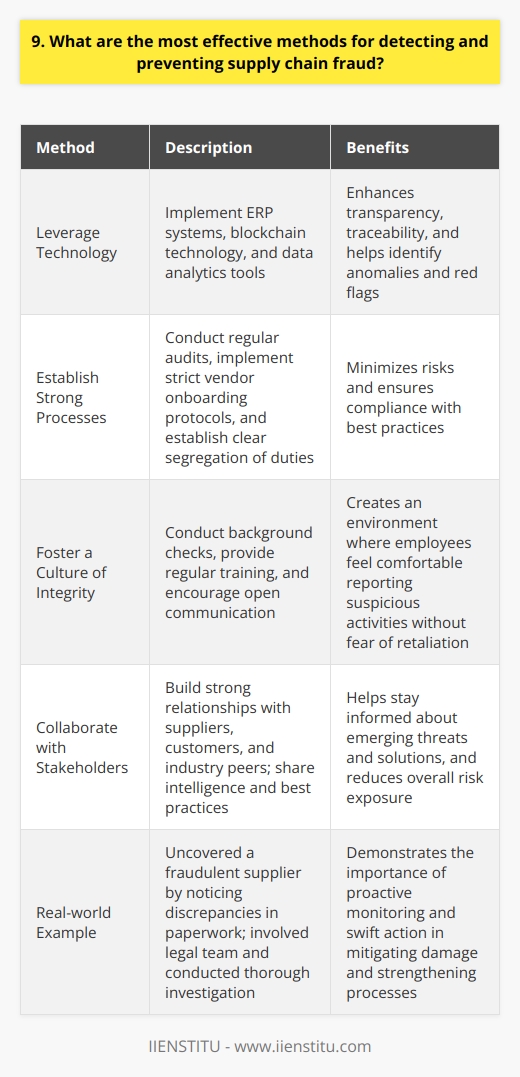
10. How can organizations foster a culture of security awareness among supply chain employees?
Organizations can foster a culture of security awareness among supply chain employees through several key strategies:
Continuous Education and Training
I believe that regular training sessions are essential to keep employees informed about the latest security threats and best practices. Last year, our company implemented quarterly cybersecurity workshops, and I noticed a significant improvement in employee awareness and engagement.
Gamification and Interactive Learning
Making security training fun and interactive through gamification techniques can greatly enhance employee participation and retention. I once participated in a cybersecurity escape room challenge, and it was an incredibly effective way to learn and apply security concepts in a hands-on manner.
Leadership Involvement and Support
When top management actively promotes and participates in security initiatives, it sends a strong message to employees about the importance of security. I remember our CEO personally introducing a new security policy and emphasizing its significance, which motivated everyone to take it seriously.
Encouraging Reporting and Open Communication
Employees should feel comfortable reporting security concerns or incidents without fear of repercussions. Establishing clear reporting channels and fostering open communication can create a proactive security culture. In my previous job, we had a dedicated email address for reporting security issues, and it helped identify and address potential threats promptly.
Integrating Security into Daily Operations
Security should be seamlessly integrated into daily work processes and procedures. This can be achieved through security checklists, reminders, and incorporating security considerations into project planning and decision-making. I find that having security as a regular agenda item in team meetings keeps it top of mind for everyone.
By implementing these strategies, organizations can cultivate a strong culture of security awareness among supply chain employees, ultimately strengthening the overall security posture of the company.
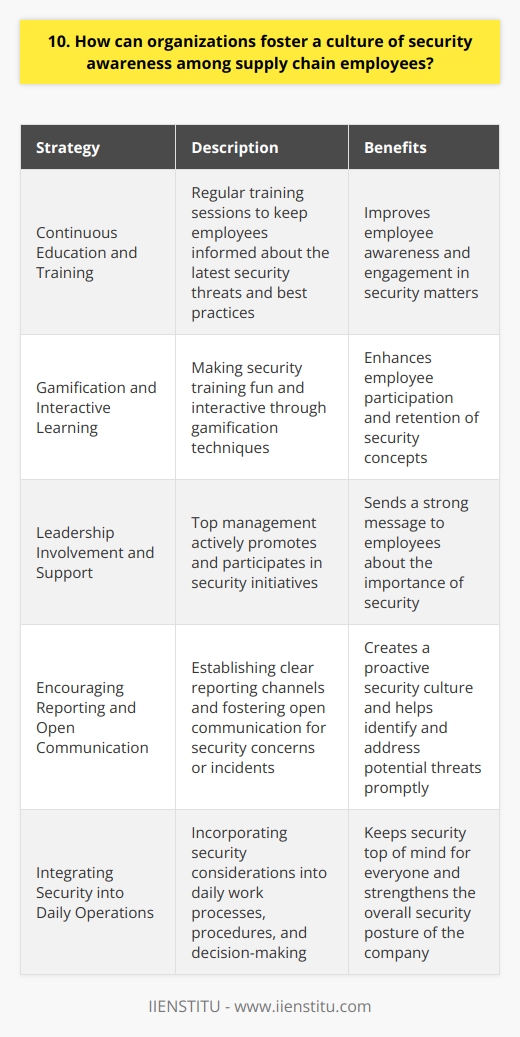
11. What are the key elements of a robust supply chain risk management plan?
When it comes to creating a robust supply chain risk management plan, there are several key elements to consider. Based on my experience working in logistics and supply chain management, I've found that the following components are crucial:
Identifying Potential Risks
The first step is to identify all the potential risks that could disrupt your supply chain. This might include natural disasters, geopolitical events, supplier bankruptcies, or even cyberattacks. It's important to be thorough and consider risks at every stage of the supply chain.
Assessing Impact and Likelihood
Once you've identified the risks, you need to assess their potential impact and likelihood of occurring. Consider factors like how long it would take to recover from a disruption, how much it would cost, and what the ripple effects might be. Prioritize the risks based on their severity and probability.
Developing Mitigation Strategies
With your risks prioritized, start developing strategies to mitigate them. This could involve diversifying your supplier base, building up inventory buffers, or investing in technology to improve visibility and communication. The goal is to minimize the impact of disruptions and ensure business continuity.
Establishing Contingency Plans
No matter how well you plan, disruptions can still happen. That's why it's crucial to have contingency plans in place. These should outline clear steps to take in case of an emergency, including who's responsible for what and how you'll communicate with stakeholders.
Monitoring and Reviewing
Finally, it's important to continuously monitor and review your risk management plan. As your business grows and evolves, so will your supply chain risks. Regularly assess your plan's effectiveness, update it as needed, and communicate any changes to your team.
In my experience, companies that prioritize these key elements are better equipped to weather supply chain disruptions. It takes time and effort to develop a comprehensive plan, but it's well worth it for the peace of mind and resilience it provides.
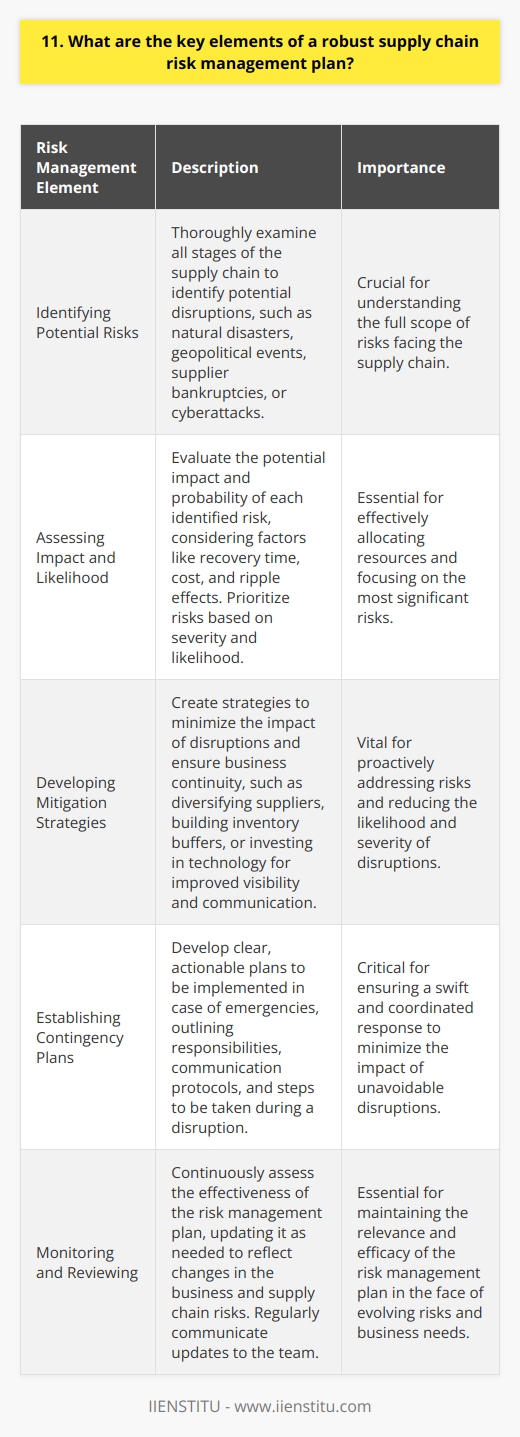
12. How can companies assess and monitor the financial stability of their suppliers?
Companies can assess and monitor the financial stability of their suppliers in several ways. First, they should request financial statements from the supplier. These statements provide valuable insights into the supplier's financial health. Companies should also conduct a thorough credit check on the supplier. This will reveal any past financial issues or red flags.
Importance of Regular Monitoring
It's not enough to just assess a supplier's financial stability once. Companies need to monitor it regularly. They should set up a system for periodic financial reviews. This could include requesting updated financial statements on a quarterly or annual basis. It's also a good idea to keep an eye on any news or reports about the supplier. If there are signs of financial trouble, it's better to know sooner rather than later.
Building Strong Relationships
In my experience, building strong relationships with suppliers is key. When you have a good relationship, suppliers are more likely to be transparent about their financial situation. They'll be more willing to share information and work with you if issues arise. I once worked with a supplier who was going through a tough time. Because we had a strong relationship, they were upfront with us. We were able to work together to find a solution that worked for both parties.
Diversifying Supplier Base
Another strategy is to diversify your supplier base. Don't put all your eggs in one basket, as the saying goes. If you rely too heavily on one supplier and they experience financial issues, it could have a big impact on your business. By having multiple suppliers, you spread out the risk. If one supplier has problems, you have others to fall back on.
In conclusion, assessing and monitoring the financial stability of suppliers is crucial. It requires a multi-faceted approach. Request financial statements, conduct credit checks, and monitor regularly. Build strong relationships and diversify your supplier base. By taking these steps, companies can mitigate risk and ensure a stable supply chain.
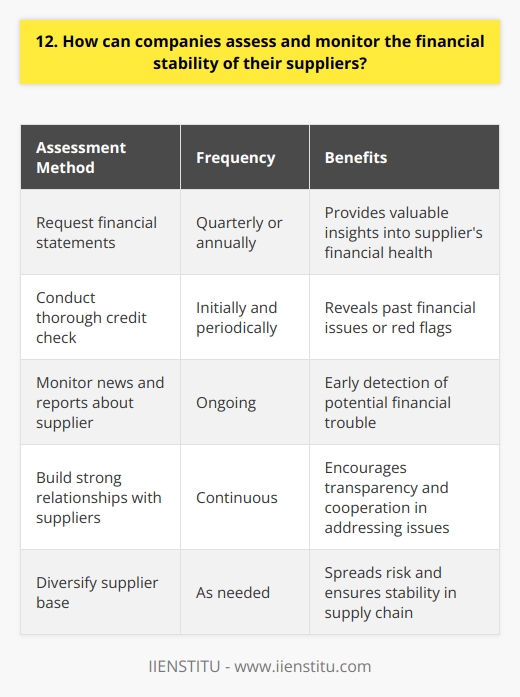
13. What steps can be taken to ensure the physical security of warehouses and distribution centers?
As a security professional, I've seen firsthand the importance of physical security in warehouses and distribution centers. Ensuring the safety of inventory, equipment, and personnel is crucial for any business. Here are some steps that can be taken to improve physical security:
Access Control
One of the most effective ways to enhance security is through strict access control measures. This includes:
Surveillance Systems
Installing a comprehensive surveillance system is another critical step. Consider the following:
Employee Training
Don't underestimate the importance of educating your staff about security protocols. Make sure to:
By implementing these measures, you can significantly reduce the risk of theft, vandalism, and other security threats. It's an investment in the safety and success of your business.
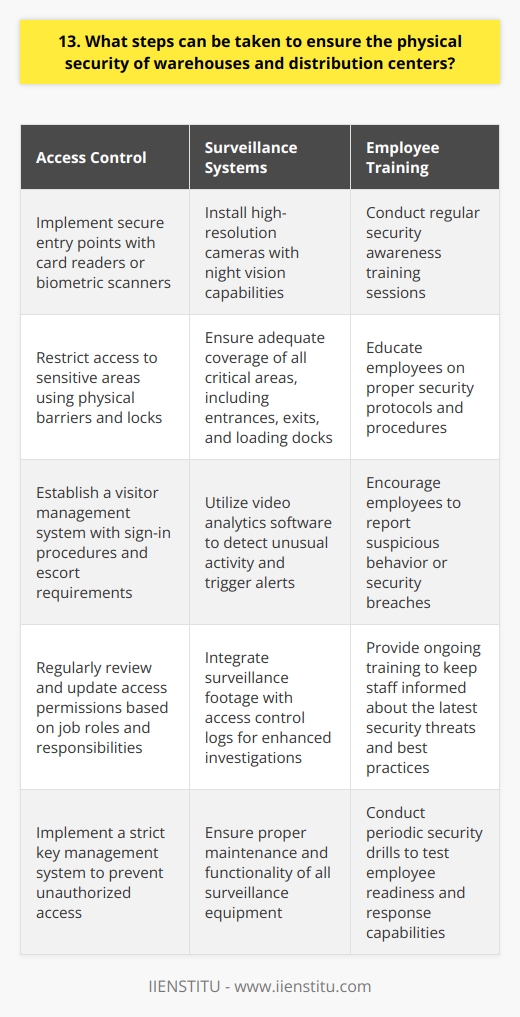
14. How can businesses effectively collaborate with law enforcement to combat supply chain crimes?
Businesses can effectively collaborate with law enforcement to combat supply chain crimes in several ways. By establishing open lines of communication and regularly sharing information, businesses and law enforcement can work together to identify potential threats and develop strategies to mitigate them.
Building Trust and Collaboration
One of the most important things businesses can do is build trust with law enforcement. This means being transparent about their operations and any potential vulnerabilities in their supply chain. It also means being willing to share information and intelligence that could help prevent or solve crimes.
I remember a case where a company I worked with had been experiencing a series of thefts from their warehouses. By working closely with local law enforcement and sharing security camera footage and other evidence, we were able to identify the culprits and put a stop to the thefts.
Investing in Technology and Training
Another key aspect of collaboration is investing in technology and training. Businesses should ensure that their employees are trained to recognize and report suspicious activity, and that they have the tools and technology in place to detect and prevent crimes.
For example, many companies are now using blockchain technology to track and verify the authenticity of their products as they move through the supply chain. This helps to prevent counterfeiting and other forms of fraud.
Participating in Industry Groups and Initiatives
Finally, businesses can collaborate with law enforcement by participating in industry groups and initiatives aimed at combating supply chain crimes. These groups bring together businesses, law enforcement, and other stakeholders to share best practices and develop coordinated strategies for preventing and responding to crimes.
I've seen firsthand the impact that these groups can have. By working together and sharing information and resources, we can make it much harder for criminals to operate and help ensure the integrity of our supply chains.
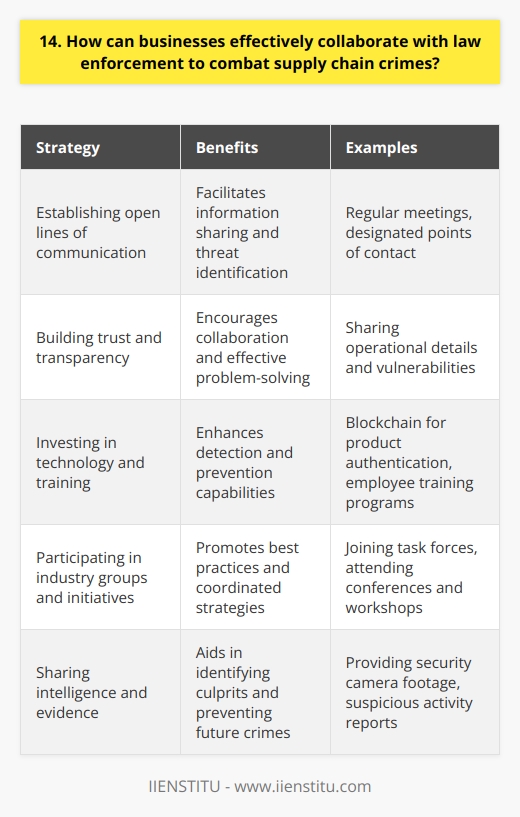
15. What are the best practices for implementing secure payment systems in supply chains?
When implementing secure payment systems in supply chains, there are several best practices to follow. First and foremost, encryption is key. All sensitive data, including payment information, should be encrypted both in transit and at rest. This helps protect against data breaches and unauthorized access.
Tokenization: A Powerful Security Tool
Another important practice is tokenization. Instead of storing actual payment card numbers, tokens can be used as a substitute. Even if a hacker gains access to the tokens, they won't be able to use them for fraudulent transactions. I remember when my company first implemented tokenization - it gave me peace of mind knowing that our customers' data was better protected.
The Importance of Compliance
Compliance with industry standards, such as PCI DSS, is also crucial. These standards provide a framework for securing payment systems. By adhering to them, you can ensure that your systems meet the necessary security requirements. It's not always easy to achieve compliance, but it's worth the effort to keep your customers' trust.
Regularly Update and Monitor Systems
Regularly updating and patching your systems is another key practice. New vulnerabilities are constantly being discovered, so it's important to stay on top of updates. Monitoring your systems for suspicious activity is also essential. By catching potential issues early, you can prevent them from turning into major problems.
Partner with Reputable Payment Processors
Finally, it's important to partner with reputable payment processors. Look for processors that have a strong track record of security and compliance. They should also offer features like fraud detection and chargeback management. By working with a trusted partner, you can focus on your core business while knowing that your payments are in good hands.
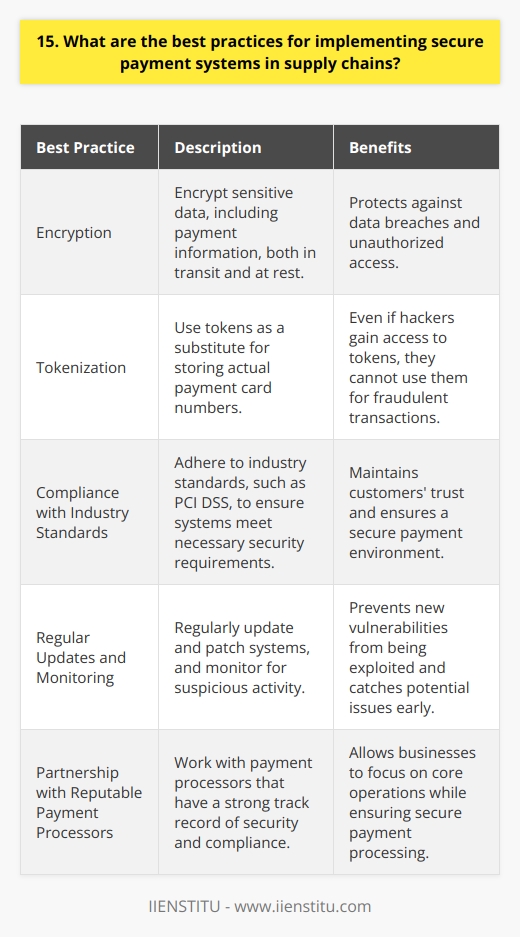
16. How can organizations ensure the integrity of their supply chain data and analytics?
As a supply chain manager, I understand the importance of ensuring the integrity of supply chain data and analytics. Here are some strategies that organizations can implement:
Establish Strict Data Governance Policies
Implementing clear data governance policies is crucial. These policies should define who has access to sensitive data, how it's collected, stored, and used. Regular audits can help ensure compliance.
Invest in Robust Security Measures
Organizations must invest in strong security measures to protect their supply chain data from breaches and unauthorized access. This includes firewalls, encryption, and multi-factor authentication. Regularly updating software and conducting security assessments are also important.
Foster a Culture of Data Integrity
Encouraging a culture that values data integrity is essential. Employees should understand the importance of accurate data and be trained on best practices. Leading by example and rewarding integrity can reinforce this culture.
Leverage Blockchain Technology
Blockchain technology offers a secure and transparent way to track supply chain data. It creates an immutable record of transactions, making it difficult to tamper with data. Exploring blockchain solutions can enhance data integrity.
Collaborate with Trusted Partners
Working with trusted suppliers and partners who share your commitment to data integrity is key. Conduct thorough due diligence and establish clear data sharing agreements. Regular communication and collaboration can help maintain data quality.
In my experience, a multi-faceted approach that combines strong policies, advanced technology, and a culture of integrity is the best way to ensure supply chain data remains accurate and trustworthy. It takes effort, but the benefits are well worth it.
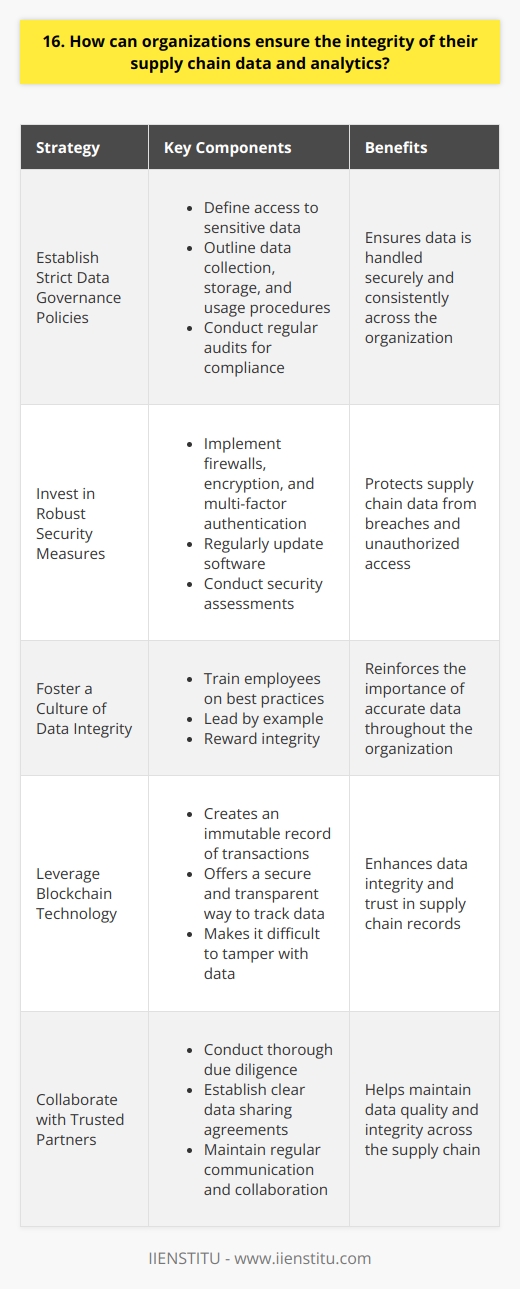
17. What measures can be taken to prevent the introduction of counterfeit components in manufacturing?
As a quality control manager, I understand the importance of preventing counterfeit components from entering the manufacturing process. Here are some measures I would implement:
Establish Strict Supplier Vetting Procedures
I would thoroughly investigate potential suppliers, verifying their reputation, certifications, and references before establishing partnerships. Only trustworthy suppliers with proven track records would be considered.
Implement Rigorous Incoming Inspection Processes
All incoming components would undergo stringent visual, functional, and technical inspections to identify any suspicious irregularities. My team would be trained to recognize common signs of counterfeiting.
Utilize Advanced Testing Technologies
Investing in state-of-the-art testing equipment, such as X-ray machines and chemical analysis tools, would help detect counterfeit components that may pass visual inspections.
Foster Strong Relationships with Suppliers
Building long-term, transparent relationships with suppliers is crucial. Regular communication, site visits, and collaboration would help ensure the integrity of the supply chain.
Educate Employees on Counterfeit Detection
I would implement training programs to educate all relevant employees about the risks of counterfeits and how to identify them. Empowering the workforce is key to prevention.
In my previous role, we once discovered a batch of counterfeit components that slipped through initial inspections. It was a stressful situation, but by following these measures and working closely with our suppliers, we were able to identify the source and prevent any further incidents. Implementing these steps takes effort, but it's essential to protect the integrity of our products and the safety of our customers.
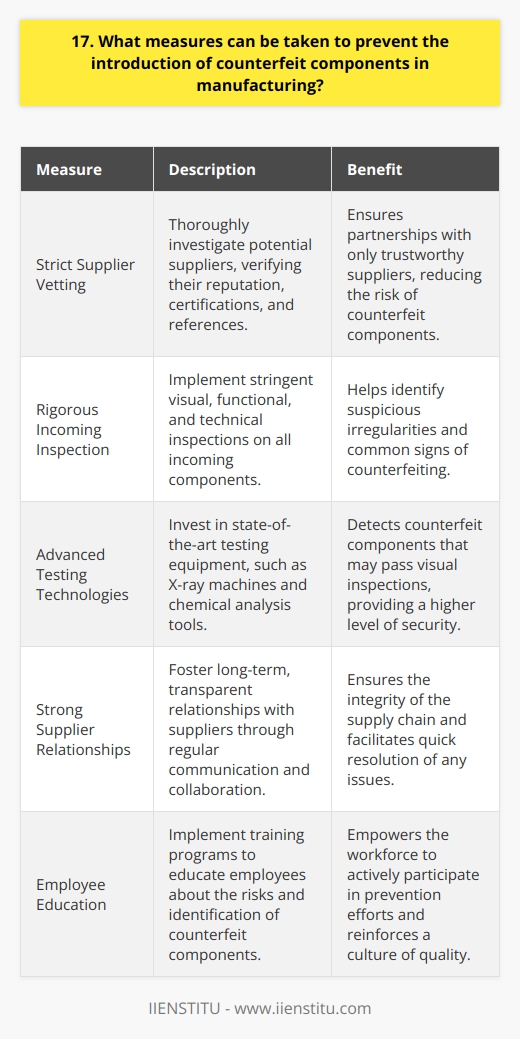
18. How can companies protect their supply chains from cyber threats and attacks?
As a cybersecurity professional, I've seen firsthand the devastating effects of cyber attacks on supply chains. To protect against these threats, companies must take a proactive, multi-layered approach.
Assess Risks and Vulnerabilities
The first step is conducting a thorough risk assessment to identify potential weaknesses. This involves examining both internal systems and those of suppliers and partners. Regular vulnerability scanning and penetration testing are essential.
Implement Strong Security Controls
Based on the risk assessment, implement robust security measures. These may include:<ul><li>Encrypting sensitive data both at rest and in transit</li><li>Enabling multi-factor authentication for all user accounts</li> <li>Segmenting networks to limit the blast radius of any breach</li><li>Keeping all software and systems updated with the latest security patches</li></ul>
Monitor and Respond
Vigilant monitoring is critical for detecting threats quickly. Invest in tools like intrusion detection systems and security information and event management (SIEM) platforms. Have a well-practiced incident response plan ready to contain any incidents rapidly.
Secure the Human Element
Many attacks exploit human error, so don't neglect employee training. Educate staff on spotting phishing emails, using strong passwords, and handling data securely. Establish clear security policies and insɪst that all suppliers do the same.
By layering these defenses and remaining ever-watchful, companies can significantly reduce the risk of becoming the next victim of a devastating supply chain attack. There are no guarantees in cybersecurity, but proactivity and vigilance go a long way.
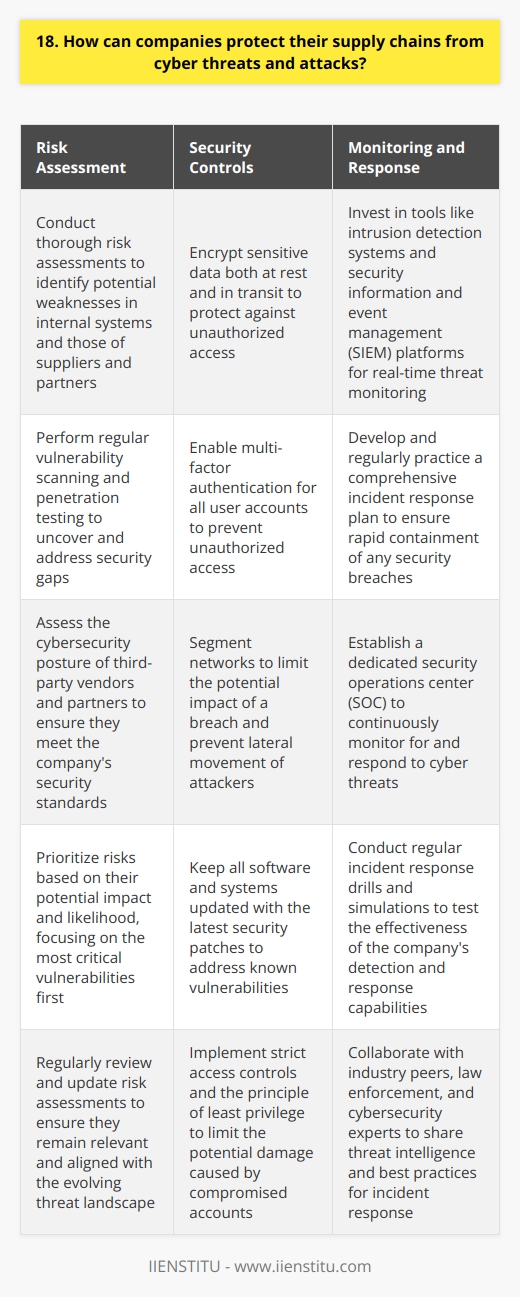
19. What are the most effective methods for conducting supplier audits and assessments?
When conducting supplier audits and assessments, I believe that thorough preparation is key. Before the audit, I review all relevant documentation and create a detailed checklist. This helps me stay focused and organized during the assessment.
On-Site Inspections
I've found that on-site inspections are one of the most effective methods. Visiting the supplier's facility allows me to observe their processes firsthand. I can assess the quality of their equipment, materials, and work environment. It's an opportunity to identify potential risks or areas for improvement.
Open Communication
During audits, I prioritize open communication with the supplier. I ask questions, listen actively, and encourage dialogue. Building a rapport helps suppliers feel comfortable sharing information and discussing challenges. It's important to create a collaborative atmosphere rather than an interrogative one.
Data Analysis
Analyzing data is another crucial aspect of supplier assessments. I review quality metrics, delivery performance, and customer feedback. This helps identify trends and patterns. If I notice recurring issues, I dig deeper to understand the root causes.
Continuous Monitoring
Effective supplier management doesn't end after the initial audit. I believe in continuous monitoring and follow-up. Regular check-ins help ensure that suppliers are implementing agreed-upon actions. It's also a chance to provide support and maintain strong partnerships.
In my experience, a combination of these methods yields the best results. By being thorough, communicative, and data-driven, we can conduct meaningful audits that drive supplier performance and mitigate risks.
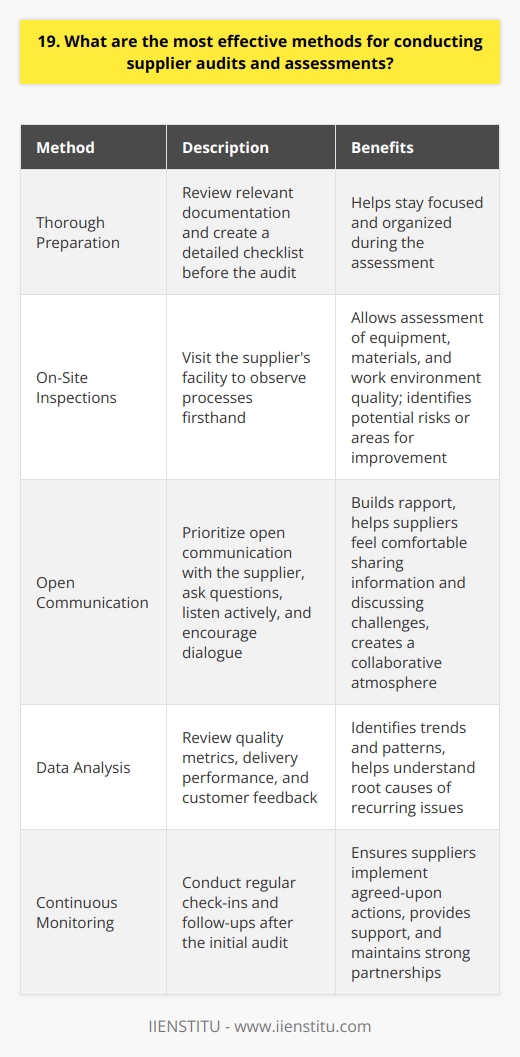
20. How can businesses ensure the security and integrity of their reverse logistics processes?
To ensure the security and integrity of reverse logistics processes, businesses can implement several strategies:
Establish Clear Policies and Procedures
Having well-defined guidelines for handling returned products is crucial. These policies should cover every step of the process, from receiving the item to inspecting it and determining its final destination. By setting clear expectations and protocols, businesses can minimize confusion and errors.
Invest in Technology Solutions
Leveraging technology can greatly enhance the security and efficiency of reverse logistics. Implementing a robust inventory management system allows for real-time tracking of returned items. Additionally, using scanners and barcodes helps ensure accurate documentation and reduces the risk of misplaced or lost products.
Conduct Regular Audits and Inspections
Performing periodic audits of the reverse logistics process is essential for identifying potential vulnerabilities or areas for improvement. This includes carefully inspecting returned items to verify their condition and authenticity. Regular audits help detect any discrepancies or fraudulent activities early on.
Train and Educate Employees
Providing comprehensive training to staff involved in reverse logistics is vital. They should be well-versed in the company's policies, procedures, and security measures. Employees should also be trained to identify potential red flags, such as counterfeit products or suspicious return patterns.
Foster Strong Partnerships
Building strong relationships with suppliers, distributors, and logistics partners is key to maintaining a secure reverse logistics chain. Clearly communicate expectations, establish service level agreements, and regularly assess their performance. Collaborating closely with trusted partners helps ensure that returned products are handled responsibly and securely throughout the entire process.
By implementing these strategies, businesses can significantly enhance the security and integrity of their reverse logistics operations, protecting both their bottom line and customer trust.

21. What strategies can be employed to prevent the infiltration of organized crime in supply chains?
As a supply chain professional, I believe that preventing organized crime infiltration requires a multi-faceted approach. In my experience, implementing robust security measures and fostering strong partnerships are key strategies.
Enhance Security Measures
I've found that conducting thorough background checks on all suppliers and partners is crucial. This helps identify any potential red flags or connections to criminal activities. Implementing strict access controls and monitoring systems throughout the supply chain can also deter and detect unauthorized activities.
Collaborate with Law Enforcement
Building strong relationships with law enforcement agencies has proven invaluable in my career. Regularly sharing information and intelligence can help identify and disrupt organized crime networks. I believe that active collaboration and timely reporting of suspicious activities are essential for effective prevention.
Promote Transparency and Traceability
In my opinion, increasing transparency and traceability throughout the supply chain is vital. Leveraging technologies like blockchain can create an immutable record of transactions, making it harder for criminals to infiltrate undetected. I've seen how implementing end-to-end tracking systems can help identify anomalies and potential points of vulnerability.
Educate and Train Employees
I strongly believe that empowering employees with knowledge is a powerful defense against organized crime. Conducting regular training sessions on identifying and reporting suspicious activities can create a vigilant workforce. In my experience, fostering a culture of awareness and accountability at all levels of the organization is essential.
Ultimately, preventing organized crime infiltration in supply chains requires a proactive and collaborative approach. By implementing robust security measures, collaborating with law enforcement, promoting transparency, and educating employees, we can create a formidable defense against criminal activities.

22. How can organizations effectively train their supply chain personnel in security best practices?
Organizations can effectively train their supply chain personnel in security best practices through a combination of methods. I believe that a comprehensive approach is crucial for success. Here are some key strategies I recommend:
Provide Engaging Training Programs
Develop interactive and engaging training programs that capture the attention of supply chain personnel. Use real-world examples and case studies to illustrate the importance of security best practices. I once participated in a training session that included role-playing exercises, and it really helped me understand the practical application of security measures.
Encourage Continuous Learning
Encourage a culture of continuous learning within the organization. Offer regular training sessions and updates to keep personnel informed about the latest security threats and best practices. I find that staying up-to-date with industry trends and attending conferences or webinars helps me stay ahead of potential security risks.
Foster Collaboration and Knowledge Sharing
Promote collaboration and knowledge sharing among supply chain personnel. Encourage them to share their experiences, insights, and best practices with each other. I've found that having open discussions with my colleagues has helped me learn from their unique perspectives and identify areas where we can strengthen our security measures.
Implement Practical Exercises and Simulations
Incorporate practical exercises and simulations into the training program. This allows personnel to apply their knowledge in a controlled environment and reinforces the importance of following security protocols. I remember participating in a simulated security breach scenario, and it really highlighted the critical role each individual plays in maintaining the integrity of the supply chain.
By implementing these strategies, organizations can create a strong foundation for security best practices within their supply chain. It's essential to foster a culture of vigilance, continuous improvement, and shared responsibility among all personnel. With the right training and support, supply chain professionals can become the first line of defense against potential security threats.
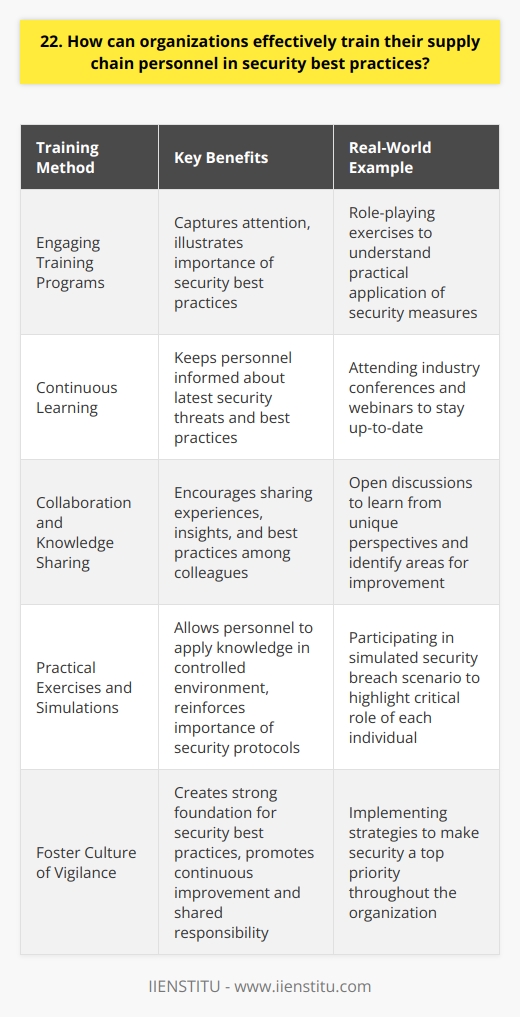
23. What are the key considerations when implementing a secure supply chain communication system?
When implementing a secure supply chain communication system, there are several key considerations to keep in mind. In my experience working on supply chain projects, I've found that focusing on these areas is crucial for success:
Encryption and Data Protection
Ensuring that all data transmitted within the supply chain is encrypted is essential. Use strong encryption protocols like AES or TLS to protect sensitive information from unauthorized access. Additionally, implement secure storage solutions for data at rest.
Access Control and Authentication
Strict access controls should be in place to ensure that only authorized individuals can access the system. Implement multi-factor authentication (MFA) and role-based access control (RBAC) to prevent unauthorized entry. Regular audits of user accounts are also important.
Network Security
Secure the network infrastructure supporting the supply chain communication system. Use firewalls, intrusion detection systems (IDS), and virtual private networks (VPNs) to protect against cyber threats. Regularly update and patch all systems to address vulnerabilities.
Compliance and Regulations
Ensure that the communication system complies with relevant industry standards and regulations, such as GDPR, HIPAA, or ISO 27001. Stay up to date with the latest requirements and conduct regular assessments to maintain compliance.
Incident Response and Business Continuity
Have a well-defined incident response plan in place to quickly detect and respond to security breaches. Conduct regular drills to test the effectiveness of the plan. Additionally, develop a robust business continuity plan to ensure that critical operations can continue during disruptions.
In my opinion, by carefully considering these key areas and implementing appropriate security measures, organizations can establish a secure and resilient supply chain communication system. It takes effort and vigilance, but the peace of mind it provides is invaluable.

24. How can companies leverage blockchain technology to enhance supply chain security and transparency?
Companies can leverage blockchain technology to enhance supply chain security and transparency in several ways. I've personally seen the benefits of using blockchain in supply chain management while working on various projects.
Decentralized and Immutable Records
Blockchain provides a decentralized, immutable ledger that records every transaction and event in the supply chain. This means that once data is recorded on the blockchain, it cannot be altered or tampered with, ensuring the integrity and authenticity of the information.
Improved Traceability
With blockchain, each product can be tracked from its origin to the end consumer. By assigning unique identifiers to products and recording their journey on the blockchain, companies can quickly trace the source of any issues or defects, reducing the time and cost associated with recalls and investigations.
Enhanced Collaboration and Trust
Blockchain enables secure and transparent collaboration among supply chain partners. Smart contracts can automate processes and ensure that all parties adhere to predefined rules and conditions. This fosters trust and eliminates the need for intermediaries, streamlining operations and reducing costs.
Real-Time Visibility and Monitoring
With blockchain, companies can gain real-time visibility into the supply chain. They can monitor the movement of goods, track inventory levels, and receive alerts for any deviations or anomalies. This enables proactive decision-making and helps prevent potential disruptions.
Combating Counterfeits and Fraud
Blockchain technology can help combat counterfeiting and fraud in the supply chain. By assigning unique digital identities to products and verifying their authenticity at each stage, companies can ensure that only genuine products reach the market, protecting their brand reputation and consumer trust.
In my experience, implementing blockchain technology in supply chain management requires careful planning and collaboration among all stakeholders. It's essential to choose the right blockchain platform, define clear objectives, and establish governance mechanisms to ensure the successful adoption and integration of the technology.
By leveraging blockchain, companies can significantly enhance supply chain security, transparency, and efficiency, ultimately gaining a competitive edge in today's complex and globalized business environment.
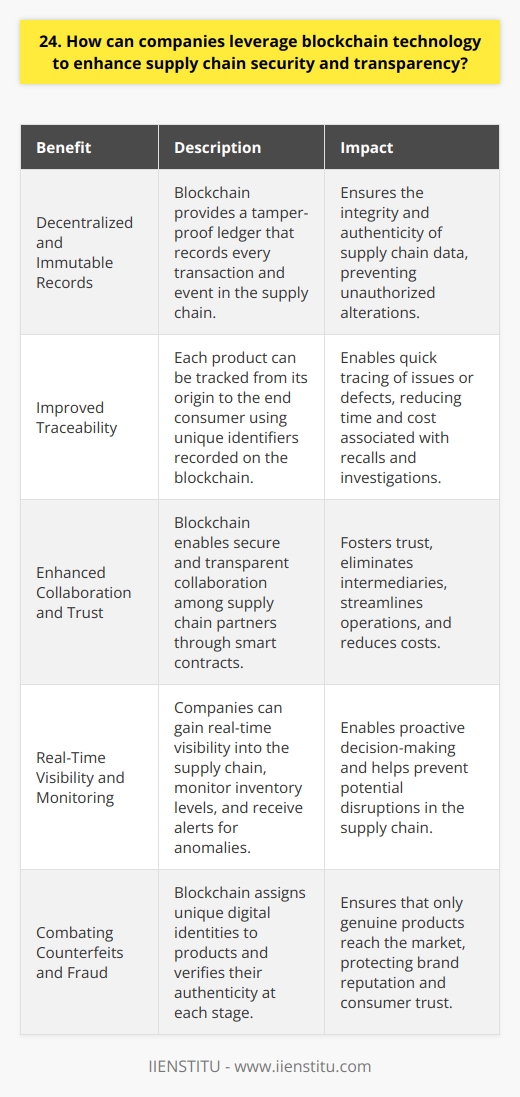
25. What measures can be taken to ensure the integrity of packaging and labeling in supply chains?
As a supply chain professional, I understand the critical importance of maintaining packaging and labeling integrity. Here are some key measures I would implement:
Establish Clear Standards and Procedures
I would work with my team to develop detailed specifications for packaging materials, designs, and labeling requirements. We'd create standard operating procedures for every step of the packaging process, from sourcing to final inspection.
Regular training sessions would ensure all staff are up-to-date on the latest protocols. Checklists and visual aids could help reinforce proper techniques.
Implement Rigorous Quality Control
Thorough testing at multiple points is essential. I'd have my QC team conduct random checks on incoming materials, during production, and before shipment.
Investing in automated vision inspection systems could help catch any labeling errors or packaging defects. AI-powered solutions are becoming impressively accurate.
Partner with Reliable Suppliers
Building strong relationships with trustworthy packaging and label suppliers is crucial. I'd carefully vet potential partners, looking at their track record, certifications, and quality management systems.
Regularly auditing our suppliers would give me confidence they're meeting our high standards. Open communication and collaboration are key.
Leverage Technology for Traceability
Implementing a robust traceability system, perhaps using RFID tags or blockchain, would allow us to track every package from origin to destination.
If any issues arise, we could quickly trace the source and take corrective action. This visibility is invaluable.
Foster a Culture of Integrity
Perhaps most importantly, I'd strive to instill a culture of integrity throughout the organization. From the warehouse floor to the executive suite, every employee must understand the importance of packaging and labeling done right.
Leading by example, rewarding attention to detail, and swiftly addressing any lapses would reinforce this commitment. With the whole team bought in, we could uphold the highest standards.
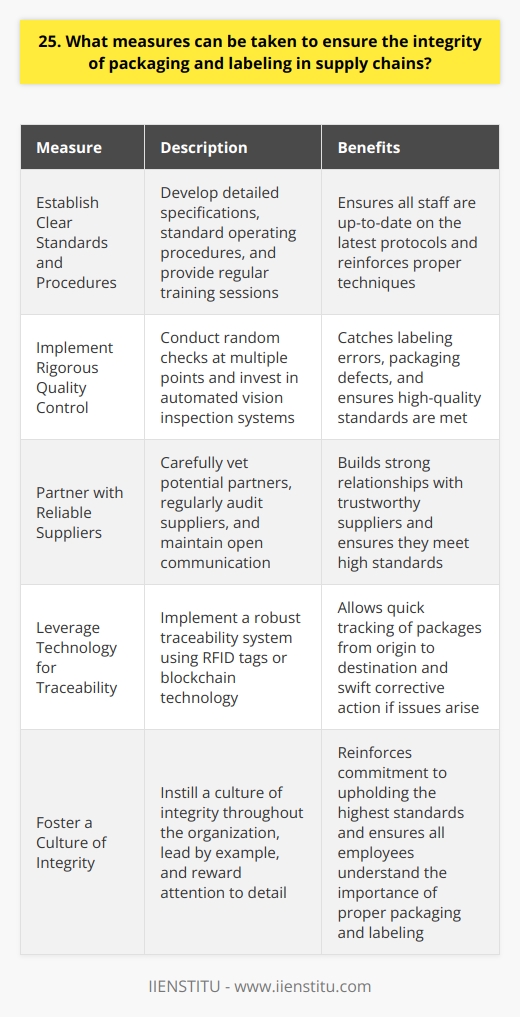
26. How can businesses establish and maintain secure relationships with third-party logistics providers?
Establishing and maintaining secure relationships with third-party logistics providers is crucial for businesses. Here are some strategies I've found effective:
Conduct Thorough Due Diligence
Before partnering with a 3PL, I always research their reputation, financial stability, and security practices. Visiting their facilities and meeting their team helps me assess their capabilities and trustworthiness.
Establish Clear Contracts and SLAs
Having detailed contracts and service level agreements is a must. I work with legal counsel to define expectations, liabilities, and penalties for non-compliance. This protects my company in case issues arise.
Implement Robust Security Measures
I insist that 3PLs follow strict security protocols, both physical and digital. Regular audits and penetration testing help identify and address vulnerabilities before they can be exploited.
Maintain Open Communication Channels
Frequent communication is key to a strong partnership. I schedule regular check-ins with my 3PL contacts to discuss performance, challenges, and opportunities for improvement. Transparency builds trust on both sides.
Foster a Culture of Continuous Improvement
I encourage my 3PLs to continuously enhance their processes and technology. Sharing best practices and investing in innovation together strengthens our relationship and keeps us ahead of the curve.
Monitor and Evaluate Performance
I closely monitor key performance indicators to ensure my 3PLs are meeting expectations. If issues arise, I address them promptly and collaboratively. Regularly evaluating the partnership helps me make informed decisions about its future.
In my experience, following these strategies has allowed me to build secure, long-lasting relationships with 3PLs. It takes effort, but the peace of mind and business benefits are well worth it.
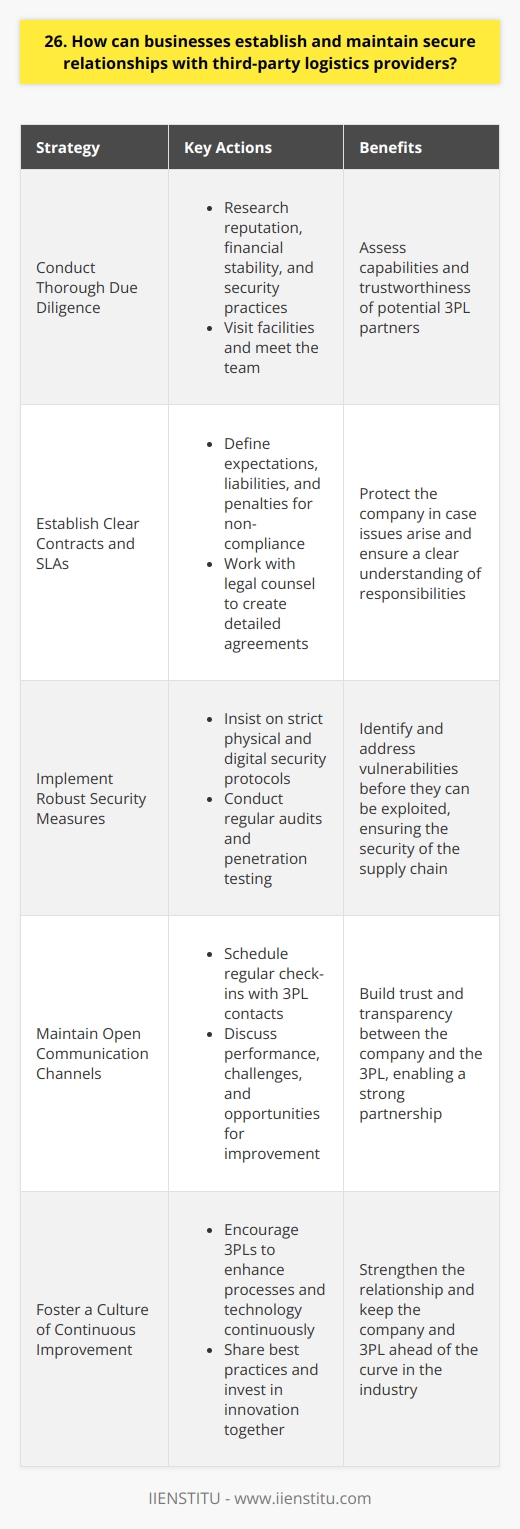
27. What are the most effective methods for detecting and preventing insider threats in supply chains?
As a supply chain security expert, I've found that a multi-layered approach works best for detecting insider threats. This includes implementing strict access controls, monitoring employee behavior, and conducting regular security audits.
Access Controls
One of the most effective methods is to limit employee access to sensitive data and systems. By using the principle of least privilege and role-based access, you can minimize the risk of unauthorized access. It's also crucial to revoke access promptly when an employee leaves the company or changes roles.
Behavioral Monitoring
Another key strategy is to monitor employee behavior for any suspicious activities or anomalies. This can include tracking login attempts, file transfers, and network traffic. I remember one case where we detected an employee attempting to download large amounts of confidential data outside of business hours. Thanks to our monitoring systems, we were able to intervene quickly and prevent a major data breach.
Security Audits
Regular security audits are also essential for identifying vulnerabilities and gaps in your supply chain security. This should include both internal assessments and third-party audits. In my experience, it's helpful to work with a trusted security partner who can provide an objective evaluation of your security posture.
Employee Training
Finally, I believe that employee training is critical for preventing insider threats. By educating your staff about security best practices and the consequences of data breaches, you can create a culture of security awareness. This can include training on topics like password security, phishing scams, and social engineering tactics.
In summary, a comprehensive approach that combines access controls, behavioral monitoring, security audits, and employee training is the most effective way to detect and prevent insider threats in supply chains. It's an ongoing process that requires vigilance and commitment from everyone in the organization.
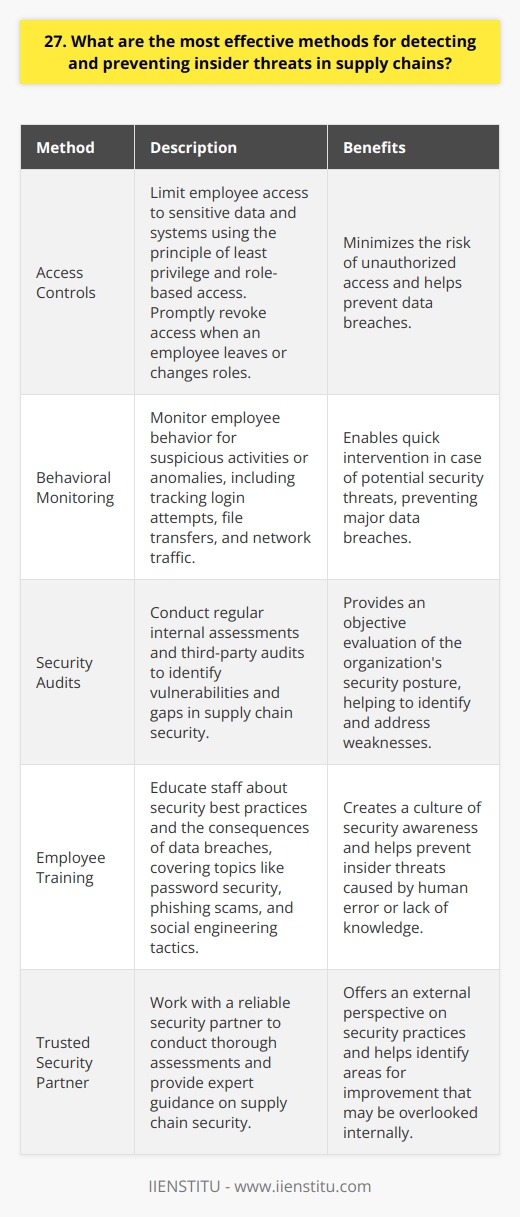
28. How can organizations ensure the security and compliance of their global supply chain operations?
Organizations can ensure the security and compliance of their global supply chain operations through several key strategies.
Implement Robust Tracking Systems
Investing in advanced tracking technologies like RFID and GPS allows companies to monitor goods in real-time. This visibility helps quickly identify and address any potential security breaches or compliance issues that may arise during transit.
Conduct Regular Risk Assessments
I believe performing frequent risk assessments is crucial for maintaining a secure supply chain. By proactively evaluating potential vulnerabilities, organizations can develop targeted mitigation plans to address identified risks before they cause significant disruptions.
Foster Strong Supplier Relationships
Building trust and transparency with suppliers is essential for ensuring compliance. In my experience, regular communication, audits, and collaborative problem-solving help align everyone with security and regulatory requirements.
Leverage Blockchain Technology
Blockchain offers a decentralized, tamper-proof record of transactions. I'm excited about its potential to enhance traceability, prevent counterfeiting, and streamline compliance documentation across complex global networks.
Prioritize Employee Training
Employees play a vital role in maintaining supply chain security. Providing comprehensive training on proper handling procedures, data protection, and identifying red flags empowers them to actively contribute to compliance efforts.
Stay Updated on Regulations
Global supply chains are subject to evolving regulations and standards. Staying informed about the latest requirements in each region of operation is necessary to avoid costly penalties and reputational damage.
While no system is foolproof, a multi-faceted approach that combines technology, processes, and people is key to fortifying supply chain security and compliance on a global scale.
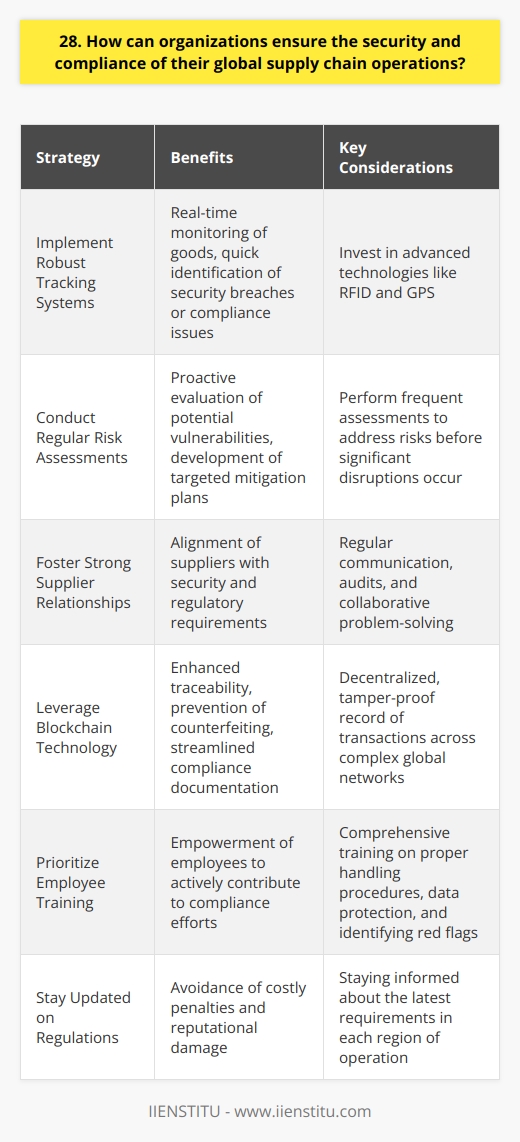
29. What strategies can be implemented to mitigate the risks associated with supply chain disruptions?
To mitigate risks associated with supply chain disruptions, I believe a multi-faceted approach is necessary. In my experience, implementing strategies that increase visibility, flexibility, and collaboration can make a significant difference.
Increase Supply Chain Visibility
One key strategy is to invest in technologies that provide real-time data across the supply chain. I've seen how tools like IoT sensors and blockchain can help identify potential issues early on, allowing for proactive decision-making.
Diversify Supplier Network
Another important tactic is to diversify the supplier network. Relying on a single supplier can be risky. I think it's wise to develop relationships with multiple suppliers in different geographic locations to minimize the impact of localized disruptions.
Build Flexibility and Redundancy
Building flexibility and redundancy into the supply chain is also crucial. This could involve creating backup plans, holding safety stock, or designing products that can accommodate component substitutions. In my view, the ability to quickly adapt is essential.
Foster Collaboration and Communication
Lastly, I believe fostering strong collaboration and communication with suppliers, partners, and customers is vital. Regularly sharing information, aligning goals, and jointly planning can help create a more resilient supply chain.
While supply chain disruptions can't be entirely avoided, I'm confident that implementing these strategies can significantly mitigate risks. It requires ongoing effort and investment, but the payoff in terms of business continuity is well worth it.
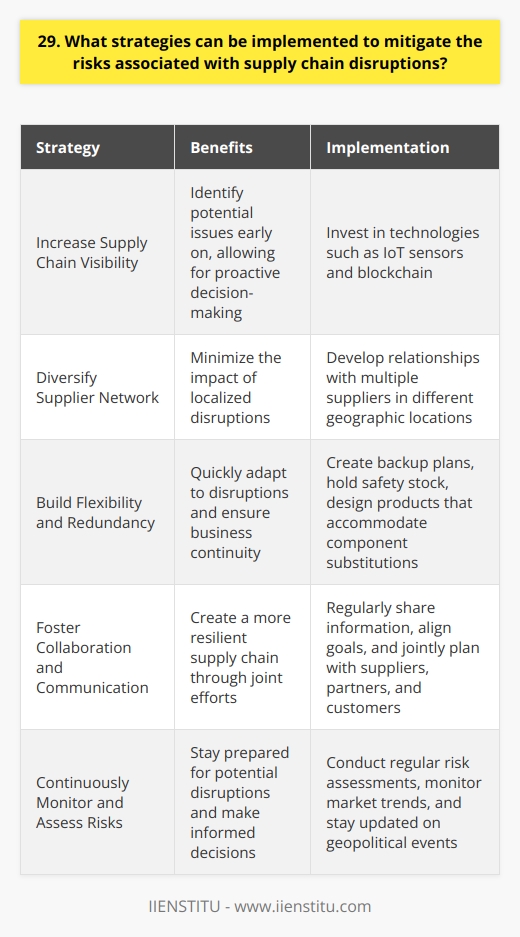
30. How can companies continuously monitor and improve their supply chain security posture?
As a supply chain professional, I believe companies can continuously monitor and improve their supply chain security posture through several key strategies:
Conduct Regular Risk Assessments
I've found that performing frequent assessments helps identify potential vulnerabilities before they become major issues. This involves evaluating suppliers, reviewing processes, and analyzing data for anomalies or red flags.
Implement Robust Monitoring Systems
In my experience, having real-time visibility across the entire supply chain is crucial. Companies should leverage tools like GPS tracking, RFID tags, and blockchain to monitor goods and detect disruptions early.
Foster Strong Supplier Relationships
I believe building trust and open communication with suppliers is vital. Regularly engaging with them, setting clear expectations, and collaboratively solving problems greatly enhances overall security.
Provide Employee Training
From what I've seen, empowering employees with the knowledge to recognize and report potential threats is key. Ongoing security awareness training keeps everyone vigilant and proactive about mitigating risks.
Embrace Continuous Improvement
In my view, supply chain security isn't a one-time effort but an ongoing journey. Companies must stay agile, learn from incidents, and adapt their strategies to address evolving risks and maintain a resilient posture.
